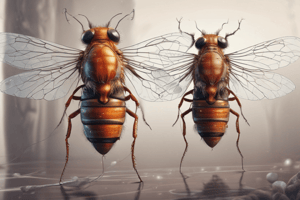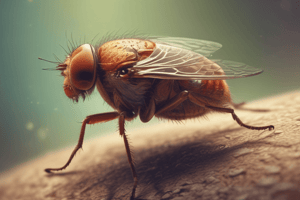Podcast
Questions and Answers
What is a distinguishing feature of female Drosophila melanogaster compared to males?
What is a distinguishing feature of female Drosophila melanogaster compared to males?
- Females have a round abdomen.
- Males have a pointed ovipositor.
- Females are smaller than males.
- Females have an abdomen that curves to a point. (correct)
Which physical characteristic is specific to male Drosophila melanogaster?
Which physical characteristic is specific to male Drosophila melanogaster?
- Males have alternating dark and light bands on their abdomen.
- Males possess a pointed ovipositor.
- Males possess a tiny tuft of hairs known as sex combs. (correct)
- Males have a larger overall size.
What feature distinguishes the markings of the female Drosophila melanogaster from the male?
What feature distinguishes the markings of the female Drosophila melanogaster from the male?
- The female has a black abdominal end.
- The female has a uniformly colored abdomen.
- The female's abdomen has alternating dark and light bands. (correct)
- The female shows fused abdominal segments.
Where are the claspers located in male Drosophila melanogaster?
Where are the claspers located in male Drosophila melanogaster?
How does the size of adult female Drosophila melanogaster compare to that of males?
How does the size of adult female Drosophila melanogaster compare to that of males?
What is one reason why Drosophila melanogaster is considered a popular genetic model organism?
What is one reason why Drosophila melanogaster is considered a popular genetic model organism?
How many days does it take for Drosophila melanogaster to develop from fertilization to adulthood?
How many days does it take for Drosophila melanogaster to develop from fertilization to adulthood?
What anatomical features of Drosophila facilitate easy identification under a microscope?
What anatomical features of Drosophila facilitate easy identification under a microscope?
At which stage does the larva of Drosophila melanogaster turn into a pupa?
At which stage does the larva of Drosophila melanogaster turn into a pupa?
Which of the following correctly describes the egg-laying capability of female Drosophila melanogaster?
Which of the following correctly describes the egg-laying capability of female Drosophila melanogaster?
What is a characteristic feature of the larval stage of Drosophila melanogaster?
What is a characteristic feature of the larval stage of Drosophila melanogaster?
What distinguishes male Drosophila melanogaster from females?
What distinguishes male Drosophila melanogaster from females?
What is the significance of having only four pairs of chromosomes in Drosophila melanogaster compared to humans?
What is the significance of having only four pairs of chromosomes in Drosophila melanogaster compared to humans?
Flashcards
Female Drosophila Size
Female Drosophila Size
Female Drosophila melanogaster is larger than the male.
Drosophila Abdomen Shape
Drosophila Abdomen Shape
Female's abdomen curves to a point; male's abdomen is round.
Markings on Drosophila
Markings on Drosophila
Females have alternating dark and light bands; males have fused segments.
Sex Combs in Drosophila
Sex Combs in Drosophila
Signup and view all the flashcards
External Genitalia of Drosophila
External Genitalia of Drosophila
Signup and view all the flashcards
Drosophila melanogaster
Drosophila melanogaster
Signup and view all the flashcards
Short Lifespan
Short Lifespan
Signup and view all the flashcards
Cultural Requirements
Cultural Requirements
Signup and view all the flashcards
Genetic Manipulation
Genetic Manipulation
Signup and view all the flashcards
Life Cycle Stages
Life Cycle Stages
Signup and view all the flashcards
Larva Stage
Larva Stage
Signup and view all the flashcards
Pupal Stage
Pupal Stage
Signup and view all the flashcards
Distinguishing Males and Females
Distinguishing Males and Females
Signup and view all the flashcards
Study Notes
Drosophila melanogaster (Fruit Fly)
- Classification:
- Domain: Eukaryota
- Kingdom: Animalia
- Phylum: Arthropoda
- Class: Insecta
- Order: Diptera
- Family: Drosophilidae
- Genus: Drosophila
- Species: melanogaster
Culturing and Breeding Drosophila melanogaster
- Culturing:
- Drosophila are easy to culture due to their small size and minimal requirements, allowing for study in small labs with limited resources.
Why is Drosophila melanogaster a Popular Genetic Model?
-
Short Lifespan:
- Fast development cycle, allows for many generations to be studied in a short period of time
- Female fruit flies can lay up to 1500 eggs in their lifetime
- Embryo emerges within 24 hours of fertilization and mature into an adult in approximately 10 days.
-
Minimal Culturing Requirements:
- Simple living needs, making them cost-effective and accessible in various laboratory settings.
-
Genetic Manipulation:
- Relatively simple genome and small number of chromosomes (4 pairs compared to 23 pairs in humans), which allows for easier manipulation. Allows researchers to track traits more readily.
-
Anatomical features:
- Easily observable features like eyes, wings, and body segments aid in identifying various genetic alterations or traits.
Drosophila Life Cycle
- Embryo: Small, oval-shaped, with two filaments at one end.
- Larva: Worm-like; use black mouth hooks to eat. Three larval instars.
- Pupa: Undergoes four days of metamorphosis; forms a hard, dark case.
- Adult: Has a head, thorax, abdomen, six legs, and two wings; can live up to a month.
Male vs Female Drosophila
- Size: Female is typically larger than male.
- Abdomen Shape: Female abdomen curves to a point; male abdomen is round.
- Markings: Alternating dark and light bands on the female's abdomen; the last few segments in male abdomen are fused.
- Sex Combs: Tiny tuft of hairs on the front legs of males.
- External Genitalia: Female has an ovipositor that is pointed; male has claspers located ventrally, which are darkly pigmented and circular in shape.
Phenotypes of Drosophila melanogaster
- Wild Type: Normal or common phenotype in a population.
- Mutant Phenotype: Traits that deviate from the wild type, arising from changes due to mutations in the wild type. Examples:
- White eyes
- Ebony body
- Vestigial wings
- Curly wings
Breeding Methods of Drosophila melanogaster
- Procedures and methods used to propagate and study fruit fly populations for research.
Tools for Culturing Drosophila
- Supplies and equipment necessary to maintain and grow Drosophila in a laboratory setting.
Studying That Suits You
Use AI to generate personalized quizzes and flashcards to suit your learning preferences.




